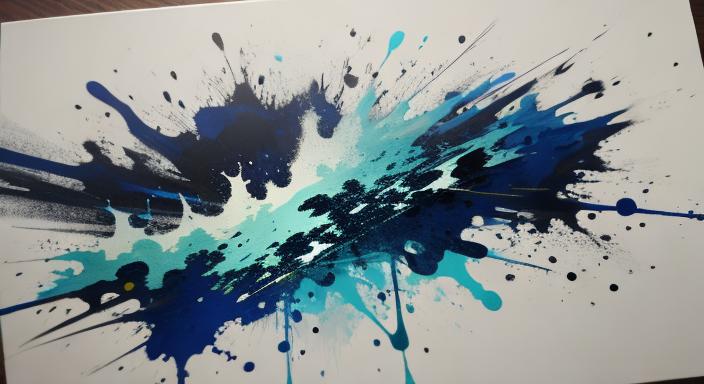Are you passionate about calligraphy and dreaming of turning your beautiful lettering into a profitable business? Selling calligraphy art has never been more accessible, with countless opportunities both online and in your local community. Whether you’re creating elegant wedding invitations, personalized gifts, or stunning wall art, the demand for handmade, custom calligraphy continues to grow as people seek unique, meaningful pieces that stand out from mass-produced alternatives.
Key Points Summary
- Build a strong portfolio and develop your unique calligraphy style before launching your business
- Price your work based on materials, time, skill level, and market research
- Leverage online marketplaces like Etsy, Instagram, and art-specific platforms to reach global customers
- Explore local opportunities including craft fairs, boutique partnerships, and wedding services
- Create passive income through digital products, fonts, and online courses
- Establish a professional online presence with a website and active social media
- Understand legal requirements including business registration and tax obligations
- Master marketing strategies to build your customer base and generate consistent sales

Building Your Foundation Before You Start Selling Calligraphy Art
Before you dive into the exciting world of selling calligraphy art, laying a solid foundation is crucial for long-term success. Think of this stage as building the roots of a tree—the stronger they are, the taller and more stable your business will grow. To find out what is calligraphy read our recent article.
Honing Your Craft and Developing Your Style
Every successful calligrapher has a recognizable signature style. This doesn’t mean copying what’s popular on Instagram. Instead, it means finding your unique artistic voice through consistent practice and experimentation.
Dedicate time each day to practice different lettering styles—from classic Copperplate and modern brush lettering to experimental hand lettering. Try various tools including pointed pens, brush pens, and markers to discover what feels most natural to you. The key is consistency: even 15-30 minutes of daily practice will dramatically improve your skills over several months.
Don’t rush this stage. Many emerging calligraphers make the mistake of trying to sell before their work is truly ready, which can damage their reputation before they’ve even started. When your style becomes distinctive enough that people recognize your work without seeing your name, you’re ready to move forward.
Creating a Professional Portfolio
Your portfolio is your most powerful sales tool. It showcases not just your technical skills, but also your versatility and creative vision. A strong portfolio should include:
- Wedding calligraphy examples: Envelope addressing, place cards, and invitation suites
- Personalized gifts: Names, quotes, and custom phrases in various styles
- Commercial work: Menu designs, signage, and branding elements
- Art pieces: Framed quotes, poetry, or original compositions
Create both a physical portfolio for in-person meetings and a digital version for online sharing. Your digital portfolio should feature high-quality photographs with consistent lighting and backgrounds. Consider investing in basic photography equipment or learning smartphone photography techniques to present your work professionally.
According to how to build your art brand, consistency in presentation helps establish credibility and trust with potential customers. Use the same color scheme, fonts, and layout across all your portfolio materials.
Understanding Copyright and Intellectual Property
This might not be the most exciting topic, but protecting your artistic creations is essential. When you create original calligraphy artwork, you automatically own the copyright to that specific piece. However, understanding the nuances helps you avoid legal issues down the road.
If you’re creating custom work using someone else’s poetry, quotes, or song lyrics, you’ll need to consider copyright restrictions. Popular quotes from recent books, movies, or songs are typically protected, and reproducing them commercially could lead to legal problems. Public domain works (generally those created before 1928 or by authors who died more than 70 years ago) are safe to use.
For wedding work, remember that each commissioned piece is a unique creation. Clarify with clients whether they’re purchasing the physical artwork only or also the rights to reproduce it for their own purposes.
Pricing Your Calligraphy Art: Finding the Sweet Spot
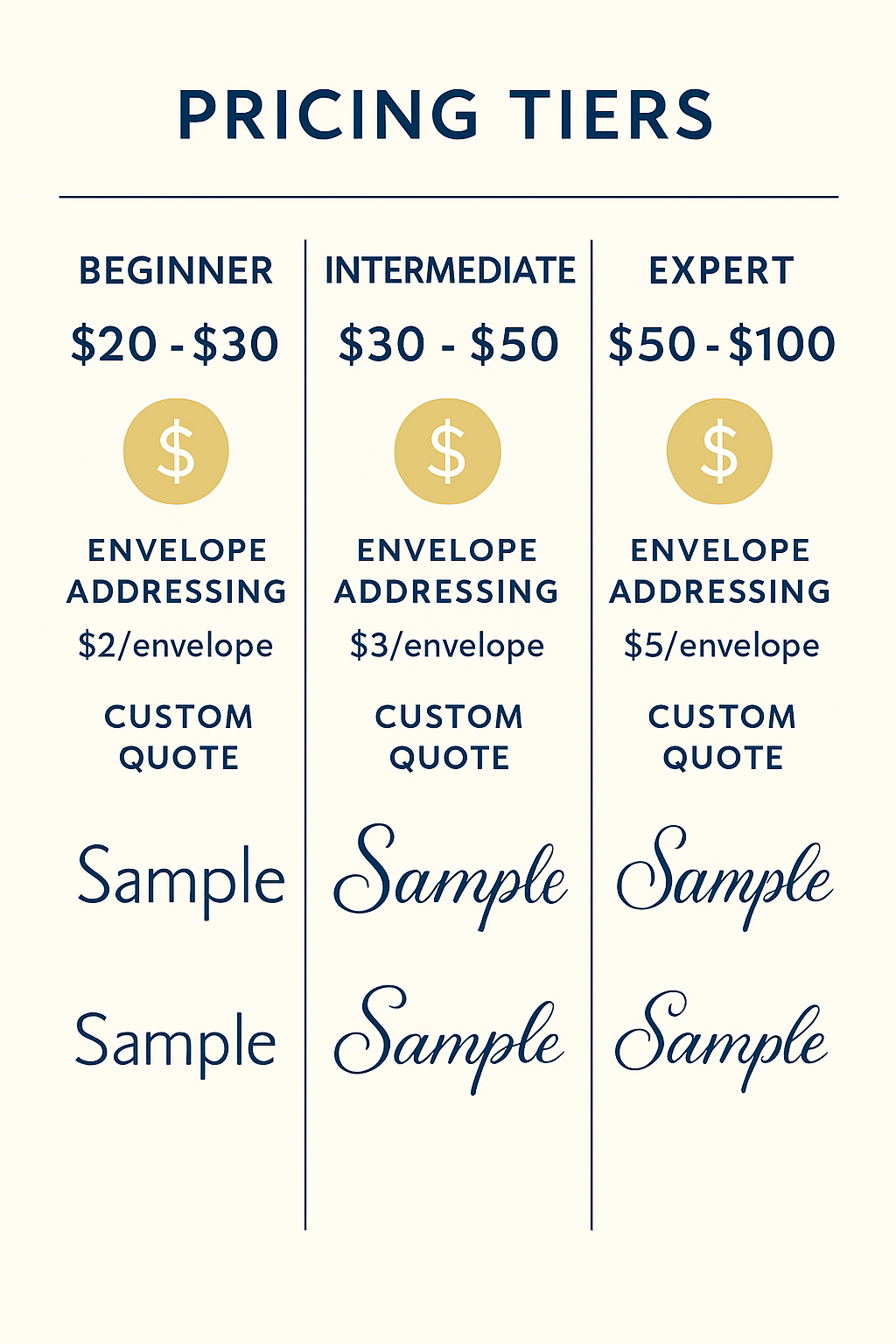
One of the biggest challenges for new calligraphers is setting prices. Charge too little, and you’ll exhaust yourself working for pennies while training customers to undervalue calligraphy. Charge too much before you’re established, and you’ll struggle to find buyers.
Start by calculating your baseline costs using this framework:
Materials Cost + Hourly Rate × Time Spent + Skill Premium = Your Price
For example:
- Paper, ink, and envelope: $5
- Your hourly rate ($25) × 2 hours = $50
- Skill premium for experience: $10
- Total: $65 for a custom envelope suite
Your hourly rate should reflect your experience level. Beginners might start at $15-25 per hour, intermediate calligraphers at $25-50, and experienced artists at $50-100+. The skill premium accounts for years of practice and your unique artistic value.
Research what other calligraphers in your area and online are charging. Check Etsy listings, local artist markets, and competitor websites. This market research, combined with understanding how to price artwork, will help you position yourself appropriately.
Don’t forget to factor in overhead costs like website hosting, packaging materials, shipping supplies, and marketing expenses. These hidden costs can eat into profits if you don’t account for them from the start.
Selling Your Calligraphy Art Online: Reaching Global Customers
The internet has revolutionized how artists sell their work, and calligraphers are no exception. Online platforms give you access to millions of potential customers worldwide, 24 hours a day. Let’s explore how to establish your online presence and start making sales.
Setting Up Your Online Presence
Your digital home base should be a combination of a professional website and strategic social media presence. Think of your website as your online gallery and shop, while social media serves as your marketing and community-building tool.
Creating a Professional Website
You don’t need to be a tech wizard to create a stunning website. Platforms like Squarespace, Wix, or Shopify offer beautiful templates specifically designed for artists and makers. Your website should include:
- A compelling homepage with your best work
- An about page that tells your story and connects with visitors emotionally
- A shop or portfolio section with clear pricing
- A contact page with an easy inquiry form
- A blog or news section (this helps with SEO)
Following what makes a good art portfolio website guidelines, ensure your site loads quickly, works perfectly on mobile devices, and showcases your calligraphy in the best possible light.
Leveraging Social Media Platforms
Instagram is arguably the most powerful platform for calligraphers. Its visual nature perfectly showcases your lettering work, and features like Stories, Reels, and Shopping make it easy to connect with potential customers and drive sales.
Post regularly (aim for 3-5 times per week) and show variety: finished pieces, work-in-progress videos, behind-the-scenes glimpses of your process, and tips for aspiring calligraphers. Use relevant hashtags like #moderncalligraphy, #weddingcalligraphy, #handlettering, and location-specific tags to increase discoverability.
Pinterest acts as a visual search engine and drives significant traffic to artist websites. Create pins featuring your calligraphy work, linking back to your website or shop. Many brides-to-be and event planners use Pinterest to find calligraphers, making it particularly valuable for wedding-focused businesses.
Facebook remains relevant, especially for connecting with local customers and joining artist communities. Create a business page, share your work regularly, and participate in local community groups where people often seek vendor recommendations.
Online Marketplaces: Where to Sell Your Calligraphy
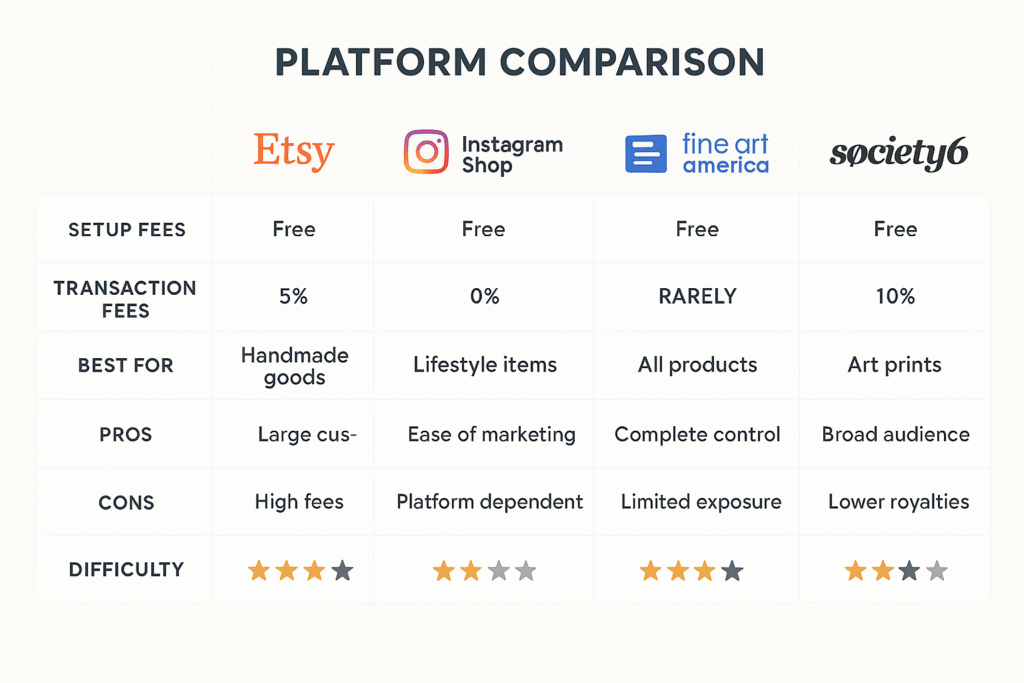
Etsy: The Handmade Marketplace Giant
Etsy remains the go-to marketplace for handmade and custom items. With millions of buyers specifically seeking unique, artisan products, it’s an excellent platform for selling calligraphy art. The platform is particularly strong for:
- Wedding calligraphy products
- Personalized gifts
- Custom name art
- Digital calligraphy downloads
Setting up shop on Etsy is straightforward, but success requires strategic optimization. Use all 13 tags per listing, write detailed descriptions with relevant keywords, and invest in high-quality product photography. Learn more about how to sell art on Etsy successfully to maximize your store’s potential.
The downside? Etsy charges listing fees ($0.20 per item), transaction fees (6.5%), and payment processing fees (3% + $0.25). These costs add up, so factor them into your pricing from the beginning.
Art-Specific Online Platforms
While Etsy dominates handmade goods, other platforms specialize in fine art and might suit your calligraphy business depending on your niche:
- Saatchi Art: Best for original artwork and fine art prints
- Fine Art America: Print-on-demand service that handles production and shipping
- Society6 and Redbubble: Print-on-demand for calligraphy designs on products like phone cases, tote bags, and wall art
These platforms handle printing, shipping, and customer service, but take a larger commission (typically 30-50%). They work best for calligraphers who want passive income without managing inventory.
Print-on-Demand Services: Scaling Without Inventory
Print-on-demand (POD) services allow you to offer your calligraphy designs on various products without holding inventory or managing shipping. You upload your designs, they print and ship each item as orders come in, and you earn a commission.
Popular POD platforms include:
- Printful: Integrates with Etsy and your own website
- Printify: Offers competitive pricing with multiple printing partners
- Zazzle: Built-in marketplace plus integration options
POD works beautifully for calligraphy because you can offer your lettering designs on mugs, t-shirts, greeting cards, wall prints, and dozens of other products. The key is choosing designs that work well across different products and appeal to broad audiences.
Understanding what is print on demand will help you decide if this revenue stream makes sense for your business model.
Creating Passive Income Through Digital Products
One of the smartest moves calligraphers can make is developing digital products that generate income while you sleep. Unlike commissioned work that trades time for money, digital products can be sold repeatedly without additional effort.
Selling Custom Calligraphy Fonts
If you’ve developed a unique lettering style, why not turn it into a digital font? Creating fonts requires specialized software like Glyphs, FontLab, or the free option Birdfont, and involves digitizing each letter, number, and symbol.
The learning curve is steep, but the payoff is substantial. Fonts can be sold on marketplaces like Creative Market, MyFonts, or FontSpring, typically ranging from $15-50 per license. Wedding calligraphy fonts, brush script fonts, and elegant serif fonts tend to sell particularly well.
Digital Downloads and Templates
Printable calligraphy products represent another excellent passive income stream. Create designs once, then sell unlimited digital copies through Etsy or your own website. Popular digital products include:
- Printable wall art quotes: Motivational phrases, nursery art, and home decor
- Practice sheets: Worksheets teaching different lettering styles
- Wedding templates: Place cards, menu templates, and invitation designs
- Planner stickers: Hand-lettered elements for digital or printable planners
Price digital downloads between $5-25 depending on complexity. Bundles of related items command higher prices and increase perceived value.
Remember to clearly communicate what customers are purchasing—a digital file, not a physical product. Specify file formats (PDF, JPG, PNG), dimensions, and whether items are for personal or commercial use.
Teaching Online: Courses and Workshops
Your knowledge and skills are valuable assets. Teaching calligraphy online through courses and workshops can become a significant income source while establishing you as an authority in your field.
Platforms like Skillshare, Udemy, and Teachable make it easy to host and sell courses. You could create:
- Beginner calligraphy courses: Introduction to basic strokes and letter formation
- Advanced technique workshops: Specialized styles or flourishing techniques
- Business-focused classes: Marketing calligraphy services or building an art business
- Style-specific tutorials: Modern calligraphy, traditional Copperplate, or brush lettering
Record once, sell forever—that’s the beauty of online courses. Yes, you’ll invest significant time upfront filming, editing, and creating course materials, but successful courses continue generating revenue for years.
Consider offering live virtual workshops too. These one-time events create urgency, allow for real-time interaction, and can be priced higher than recorded courses. Promote them through your social media channels and email list.
Selling Calligraphy Art Locally: Building Community Connections
While online sales offer incredible reach, local opportunities shouldn’t be overlooked. Selling locally builds personal connections, creates word-of-mouth marketing, and often commands higher prices due to the personal touch.
Participating in Local Markets and Fairs
Farmers’ markets, craft fairs, and art festivals provide excellent venues for selling calligraphy art and connecting directly with customers. These events let people see your work in person, watch you create pieces live, and build relationships that lead to larger commissions and referrals.
Choosing the Right Events
Research local markets carefully before applying. Consider:
- Booth fees: Range from $25 for small community markets to $500+ for major art festivals
- Expected attendance: Higher traffic usually means more sales opportunities
- Target demographic: Wedding-focused events attract different crowds than general craft fairs
- Competition: Too many calligraphers might saturate the market; being the only one gives you an advantage
Start with smaller, lower-risk markets to test your products and gain experience before investing in larger shows.
Effective Booth Setup and Display
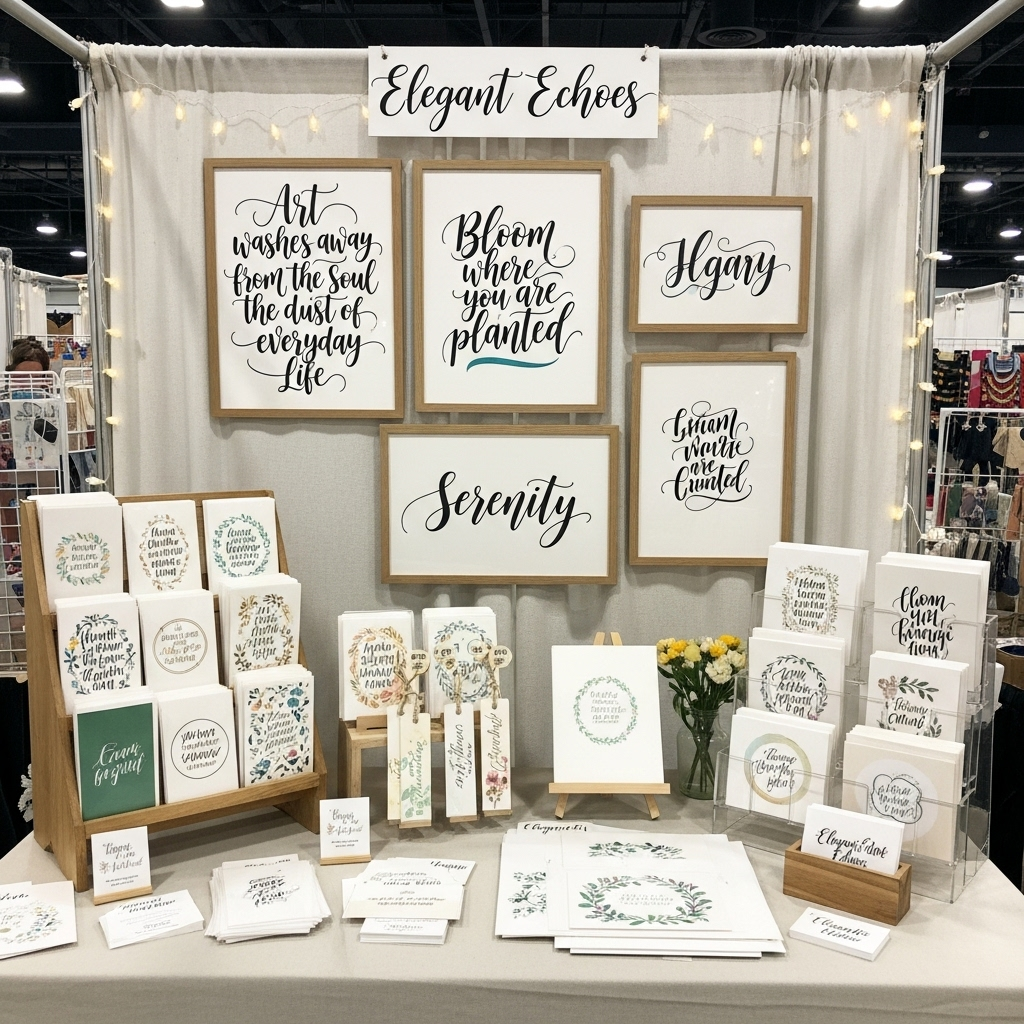
Your booth is your physical storefront for the day. Make it count with these strategies:
- Create vertical displays: Use easels, shelves, and wall panels to showcase work at eye level
- Demonstrate your craft: Live calligraphy demonstrations draw crowds and prove you’re the real deal
- Offer various price points: Have items from $5 bookmarks to $100+ custom pieces to appeal to different budgets
- Collect email addresses: Build your mailing list with a signup sheet or digital form
Bring business cards, price lists, and promotional materials for people who aren’t ready to buy immediately. Following up after events often leads to custom orders weeks or months later.
Similar to principles discussed in how to start an art business, creating memorable in-person experiences turns casual browsers into loyal customers.
Local Business Partnerships and Collaborations
Building relationships with local businesses creates steady work and valuable referrals. Think beyond traditional galleries—many businesses need calligraphy services but don’t realize it yet.
Consignment in Local Boutiques
Boutiques, gift shops, and home decor stores often welcome locally-made artwork on consignment. You provide the inventory, they display and sell it, and you split the profits (typically 60/40 or 70/30 in the artist’s favor).
Choose shops whose aesthetic aligns with your style and whose customers match your target market. Visit in person with your portfolio and several ready-to-sell pieces. Propose a trial period of 1-3 months to demonstrate how well your work sells.
Ensure you have a written consignment agreement covering:
- Commission split percentages
- How long items will be displayed
- Who handles pricing
- Responsibility for damaged or stolen items
- Payment terms
Commercial Calligraphy Services
Businesses need calligraphy for numerous purposes:
- Restaurants: Menu designs, chalkboard signs, and window lettering
- Coffee shops: Signage, specialty drink boards, and promotional materials
- Retail stores: Window displays, sale signs, and gift wrapping services during holidays
- Event venues: Directional signage, seating charts, and decorative elements
- Corporate events: Award certificates, conference signage, and presentation materials
Reach out to local businesses with a portfolio of commercial work examples (create samples if you don’t have real projects yet). Offer competitive pricing for ongoing work—steady clients are valuable even at slightly lower rates.
Live Calligraphy Events and Brand Partnerships
Live calligraphy events have exploded in popularity. Brands hire calligraphers for grand openings, product launches, weddings, and corporate events to add a personalized, artistic touch.
At these events, you might:
- Address envelopes or bags while guests wait
- Personalize products with names or initials
- Create custom artwork as keepsakes
- Demonstrate calligraphy techniques
Event work typically pays $100-300+ per hour depending on your experience and location. Network with event planners, wedding coordinators, and marketing professionals to find these opportunities.
Specializing in High-Demand Calligraphy Services
While being a generalist works, specializing in specific niches often leads to higher income and more consistent work. Let’s explore the most profitable calligraphy specializations.
Wedding Calligraphy: The Most Lucrative Niche
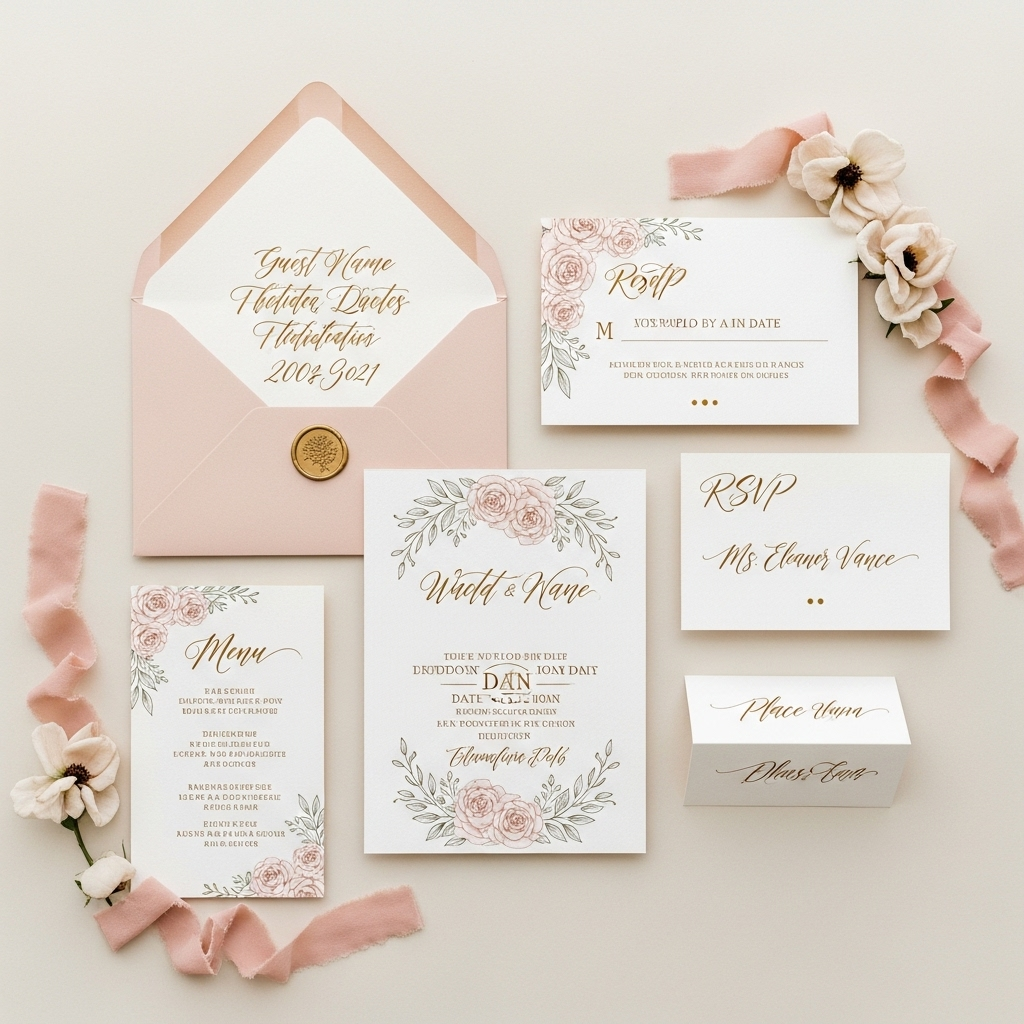
Wedding calligraphy represents one of the most profitable and consistent specializations for calligraphers. Couples planning weddings typically have higher budgets and value personalized, beautiful details that make their special day memorable.
Popular wedding calligraphy services include:
Envelope Addressing
The most requested service, envelope addressing, involves hand-lettering addresses on wedding invitation envelopes. Prices typically range from $2-8 per envelope depending on complexity, style, and your experience level.
A wedding with 150 guests might need addressing for outer envelopes, inner envelopes, and thank-you cards—that’s potentially 300-450 envelopes, representing $600-3,600 in revenue from a single client.
Invitation Suite Design
Many calligraphers expand beyond addressing to design entire invitation suites including save-the-dates, invitations, RSVP cards, and details cards. This higher-level service commands premium pricing, often $500-2,000+ per suite.
Day-Of Wedding Elements
Once you’re established in the wedding industry, you can offer day-of calligraphy including:
- Seating charts and escort cards
- Welcome signs
- Table numbers
- Menu cards
- Ceremony programs
- Thank you signage
These items are typically priced per piece or as package deals. A complete set for a 150-person wedding might total $800-2,500.
Live Wedding Calligraphy
As mentioned earlier, offering live calligraphy at weddings—personalizing place cards, favors, or creating guest artwork—can add $200-500 to your earnings for 2-3 hours of work.
Market your wedding services through:
- Wedding-focused Instagram content
- Partnerships with wedding planners and venues
- Bridal shows and expos
- Wedding vendor directories
- Pinterest boards showcasing your work
Custom Commissions and Personalized Gifts
Beyond weddings, custom calligraphy makes thoughtful gifts for countless occasions. Building a strong commission-based business requires clear processes and excellent communication.
Popular commission types include:
- Framed quotes: Song lyrics, poems, vows, or meaningful phrases ($50-200+)
- Custom names: Baby names, family names, or business names ($30-100)
- Pet portraits with calligraphy: Combining artwork with elegant lettering ($75-150)
- Anniversary or wedding vows: Couple’s first dance lyrics or wedding vows ($75-200)
Create a commission process that protects both you and your clients:
- Initial consultation: Discuss their vision, timeline, and budget
- Proposal and contract: Outline deliverables, pricing, timeline, and revision policy
- 50% deposit: Collect payment upfront to secure your time
- Sketch approval: Share initial concept for feedback
- Final creation: Complete the artwork
- Final payment and delivery: Collect remaining balance before shipping
Always include a clause limiting revisions (typically 2-3 rounds) to prevent scope creep. Understanding art commissions helps establish professional boundaries while maintaining excellent customer service.
Corporate and Event Calligraphy
Corporate clients typically have larger budgets and need calligraphy services regularly, making them valuable long-term customers. Corporate calligraphy includes:
- Corporate gifting: Holiday cards, employee appreciation certificates, and client gifts
- Conference materials: Name tags, welcome signs, and presentation materials
- Product launches: Promotional materials and event decor
- Retail collaborations: In-store events where you personalize products
Corporate work often pays premium rates ($75-150+ per hour) and can lead to ongoing relationships. Approach local companies with a professional proposal showcasing how calligraphy adds elegance and personalization to their events and communications.
Marketing and Promoting Your Calligraphy Business
Creating beautiful calligraphy is only half the equation—you also need to effectively market your services to find customers consistently. Let’s explore proven strategies to build your audience and generate sales.
Building an Email List for Direct Marketing
Your email list is your most valuable marketing asset. Unlike social media followers who see your content only when algorithms allow, email subscribers have opted in to hear from you directly.
Start building your list from day one using these strategies:
- Website opt-in forms: Offer a free resource (practice sheets, a beginner’s guide to calligraphy, or a discount code) in exchange for email addresses
- In-person signups: Collect emails at craft fairs, markets, and events
- Social media promotions: Direct followers to sign up for exclusive content or early access to new products
- Collaborations and giveaways: Partner with complementary businesses to expand reach
Send regular emails (weekly or biweekly) featuring:
- Behind-the-scenes looks at your process
- New products and services
- Exclusive offers for subscribers
- Helpful calligraphy tips and inspiration
- Personal stories that connect with readers
Email marketing platforms like Mailchimp, ConvertKit, or Flodesk offer free plans for small lists and make it easy to create beautiful, professional emails.
Leveraging Local SEO for Regional Customers
If you’re targeting local customers (wedding calligraphy, in-person workshops, or local commissions), local SEO helps people in your area find you online.
Optimize for local search by:
- Creating a Google Business Profile: This free listing appears when people search for “calligrapher near me”
- Including location keywords: Mention your city and region in website copy, blog posts, and meta descriptions
- Getting listed in local directories: Wedding vendor directories, local business associations, and community websites
- Earning local backlinks: Collaborate with local businesses, wedding planners, and publications who link back to your site
- Collecting online reviews: Ask satisfied customers to review your Google Business Profile and Facebook page
Local SEO may not be as glamorous as viral Instagram posts, but it brings qualified customers actively searching for calligraphy services in your area.
Collaborating with Other Artists and Influencers
Strategic collaborations expand your reach to audiences that already appreciate handmade, artistic products. Look for collaboration opportunities with:
- Wedding vendors: Photographers, planners, florists, and venue owners
- Complementary artists: Watercolor artists, paper goods makers, and jewelers
- Lifestyle influencers: Bloggers and Instagram creators whose aesthetic aligns with yours
- Local businesses: Gift shops, wedding boutiques, and stationery stores
Propose win-win partnerships like:
- Creating styled shoots together to showcase combined services
- Cross-promoting on social media
- Offering package deals for mutual customers
- Guest blogging or teaching workshops
- Collaborative giveaways to grow both audiences
The key is finding partners whose audiences overlap with yours but who aren’t direct competitors. A photographer’s followers likely love beautiful details and might need calligraphy services too.
Running Promotions and Building Customer Loyalty
Strategic promotions attract new customers and reward loyal ones without training people to wait for sales. Effective promotion strategies include:
Seasonal and Holiday Sales
Time promotions around natural buying periods:
- Black Friday/Cyber Monday for holiday shopping
- Valentine’s Day for romantic gifts
- Mother’s Day and Father’s Day for personalized gifts
- Wedding season (spring and summer) for wedding services
Flash Sales and Limited Offers
Create urgency with short-term sales (24-48 hours) or limited edition pieces. Scarcity motivates people to buy now rather than “someday.”
Customer Loyalty Programs
Reward repeat customers with:
- Discounts after multiple purchases
- Early access to new products
- Free shipping or bonus items
- Referral rewards for bringing new customers
Excellent customer service naturally generates referrals and repeat business. Respond promptly to inquiries, deliver on time, communicate clearly, and go above and beyond when possible. As covered in how to sell your art online, exceptional service creates word-of-mouth marketing that money can’t buy.
Legal and Business Considerations
Running a calligraphy business means more than creating beautiful lettering—you’re running an actual business with legal and financial responsibilities. Taking these seriously from the start prevents headaches later.
Registering Your Calligraphy Business
Depending on where you live and how much you earn, you may need to officially register your business. Common business structures include:
Sole Proprietorship
The simplest structure, where you and the business are legally the same entity. You report business income on your personal tax return. This works well for beginners but offers no liability protection.
Limited Liability Company (LLC)
An LLC separates your personal and business assets, protecting your personal property if someone sues your business. Formation costs and requirements vary by state, typically $50-500.
DBA (Doing Business As)
If you operate under a name different from your personal name (like “Elegant Letters Calligraphy” instead of “Jane Smith”), you’ll likely need to register a DBA. This doesn’t provide liability protection but makes your business official.
Consult with a business attorney or accountant to determine the best structure for your situation. Many calligraphers start as sole proprietors and form LLCs once their income reaches significant levels.
Understanding Tax Obligations
Yes, you must pay taxes on your calligraphy income, even if it’s just a side hustle. Common tax considerations include:
- Income tax: Report all business income on your annual tax return
- Self-employment tax: If you’re self-employed, you’ll pay both the employer and employee portions of Social Security and Medicare taxes (typically 15.3%)
- Sales tax: Most states require collecting sales tax on physical products sold within the state
- Estimated quarterly taxes: If you’ll owe more than $1,000 in taxes annually, you need to pay estimated taxes quarterly
Track all business income and expenses meticulously. Deductible expenses might include:
- Art supplies and materials
- Website hosting and domain fees
- Marketing and advertising costs
- Business travel and mileage
- Home office expenses (if you qualify)
- Professional development (courses, workshops, books)
Consider using accounting software like QuickBooks Self-Employed, FreshBooks, or Wave (free option) to simplify bookkeeping and tax preparation.
Best Practices for Shipping and Packaging
How you package and ship your calligraphy art impacts customer satisfaction and reviews. Damaged items create refund requests, negative feedback, and unnecessary stress.
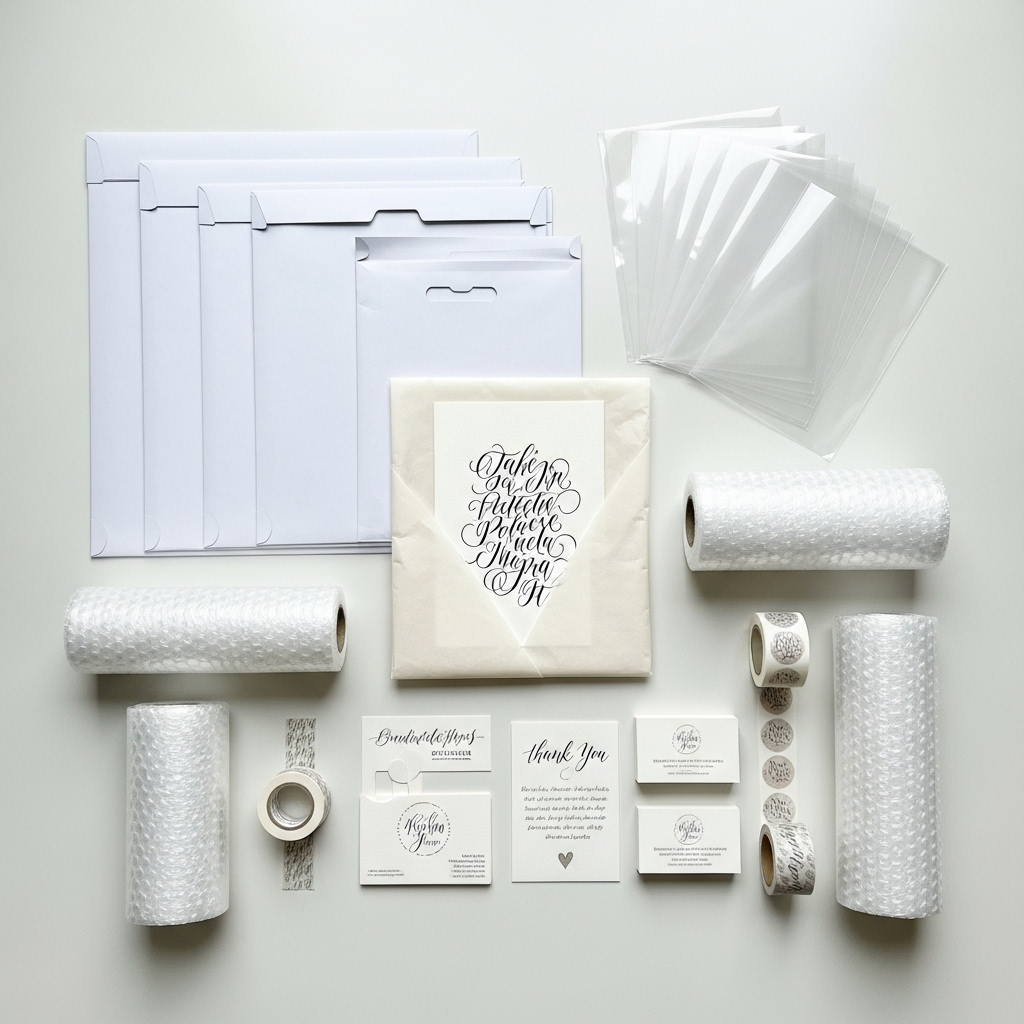
Packaging Delicate Artwork
Calligraphy pieces require protection from bending, moisture, and impact:
- Use rigid mailers or boxes rather than flexible envelopes
- Place artwork in protective plastic sleeves
- Add backing boards to prevent bending
- Include tissue paper or bubble wrap for cushioning
- Use waterproof outer packaging in case of rain
- Include care instructions and a thank-you note
Shipping Options and Insurance
Choose shipping carriers based on speed, tracking, and cost:
- USPS First Class: Economical for lightweight items under 1 pound
- USPS Priority Mail: 2-3 day delivery with free tracking and up to $50 insurance
- UPS and FedEx: Professional options for larger items or faster delivery
Always ship with tracking and consider purchasing additional insurance for high-value pieces. Build shipping costs into your pricing or charge separately at checkout.
International Shipping Considerations
Shipping internationally opens your market but adds complexity. You’ll need to complete customs forms, potentially collect VAT (Value Added Tax) for certain countries, and deal with longer delivery times.
Many calligraphers offer international shipping but charge the actual shipping cost plus a handling fee to cover the additional time and complexity.
Sustaining Your Calligraphy Business for Long-Term Success
Starting strong is one thing—building a sustainable, profitable calligraphy business for years to come requires ongoing effort, adaptation, and growth. Here’s how to ensure your business thrives long-term.
Continuous Learning and Skill Development
The most successful calligraphers never stop learning. Even after years of practice, there’s always room to refine techniques, explore new styles, and expand your creative repertoire.
Invest in your growth through:
- Online courses and workshops: Learn from master calligraphers and expand your skill set
- Books and instructional resources: Build a reference library of calligraphy guides
- Practice challenges: Participate in lettering challenges on Instagram or create personal monthly projects
- Experimentation: Try new tools, inks, papers, and styles to push creative boundaries
Just as artists benefit from understanding different painting techniques, calligraphers thrive when exploring diverse lettering approaches and staying current with trends.
Diversifying Income Streams
Relying on a single revenue source creates vulnerability. What happens if weddings slow down, a marketplace changes its policies, or economic conditions shift customer spending?
Smart calligraphers build multiple income streams:
- Custom commissions: One-on-one client work
- Ready-made products: Items sold in your shop or at markets
- Digital products: Fonts, templates, and printables
- Teaching: Online courses, workshops, and tutorials
- Wholesale: Selling to retailers in bulk
- Licensing: Licensing your designs for products made by others
- Passive income: Print-on-demand, affiliate partnerships, and ad revenue from content
No single stream needs to be perfect—together they create stability. If one slows down, others can compensate.
Building Community and Seeking Support
Running a creative business can feel isolating, especially if you work from home. Building connections with other artists provides emotional support, practical advice, and collaboration opportunities.
Find your community through:
- Online groups: Facebook groups and forums for calligraphers and lettering artists
- Local artist collectives: Join or form groups with other local creators
- Workshops and conferences: Attend calligraphy conferences and workshops to network
- Social media engagement: Actively participate in the online lettering community
When you surround yourself with other creative entrepreneurs, you gain access to shared experiences, problem-solving advice, and accountability that helps you push through challenges.
Adapting to Market Trends and Customer Preferences
The calligraphy and lettering world evolves constantly. Styles that were popular five years ago may feel dated today, while new trends emerge through social media and wedding industries. Staying relevant requires awareness and adaptability.
Monitor trends by:
- Following top calligraphers and seeing what resonates with their audiences
- Paying attention to wedding blogs and Pinterest trends
- Joining calligraphy and wedding industry Facebook groups
- Attending trade shows and conferences
- Analyzing which of your products sell best and why
However, don’t chase every trend blindly. Balance staying current with maintaining your authentic style. The goal is evolution, not abandoning what makes your work uniquely yours.
Measuring Success Beyond Income
Yes, earning money is important—it’s why you’re selling calligraphy art in the first place. But sustainable success includes other metrics that contribute to long-term fulfillment:
- Creative satisfaction: Are you enjoying the work you create?
- Work-life balance: Can you sustain this pace without burning out?
- Customer relationships: Are you building genuine connections with clients?
- Personal growth: Are you developing new skills and pushing creative boundaries?
- Impact: Is your work bringing joy and meaning to others’ lives?
When you measure success holistically, you build a business that nurtures you as much as it profits you. And that, ultimately, creates the foundation for genuine, lasting success in selling calligraphy art.

Frequently Asked Questions About Selling Calligraphy Art
How do I start selling my calligraphy?
To start selling calligraphy art, first develop your skills through consistent practice until you’ve created a distinctive style. Build a portfolio of 15-20 strong pieces showcasing various applications like wedding calligraphy, personalized gifts, and art prints. Then set up your sales channels—either online through Etsy, Instagram, or your own website, or locally through craft fairs and consignment partnerships. Price your work by calculating materials, time, and skill level, then start with friends and family to build testimonials before marketing to wider audiences.
Is selling calligraphy profitable?
Yes, selling calligraphy can be highly profitable, especially when you specialize in lucrative niches like wedding calligraphy. Experienced calligraphers regularly earn $2,000-5,000+ monthly from envelope addressing alone, while those who diversify income through digital products, teaching, and custom commissions can build six-figure businesses. However, profitability requires business savvy beyond artistic skill—effective marketing, strategic pricing, and excellent customer service are equally important. Most calligraphers start part-time and gradually scale as demand grows, treating it as a legitimate small business rather than just a hobby.
Where can I sell my calligraphy art online?
The best online platforms for selling calligraphy art include Etsy for handmade and custom pieces, Instagram for direct sales through posts and Stories, your own website built on Squarespace or Shopify for maximum control and branding, Fine Art America and Saatchi Art for fine art prints, and Society6 or Redbubble for print-on-demand merchandise featuring your designs. Many successful calligraphers use multiple platforms simultaneously—Etsy for custom orders, Instagram for marketing and community building, and their website as their professional home base. Start with 1-2 platforms to avoid overwhelm, then expand as you gain experience.
How do I price my calligraphy?
Price calligraphy using this formula: Materials Cost + (Hourly Rate × Time) + Skill Premium = Final Price. Calculate your base costs for supplies, then determine your hourly rate based on experience ($15-25/hour for beginners, $25-50 for intermediate, $50-100+ for experts). Add a skill premium reflecting your unique style and years of practice. For example, addressing a wedding envelope might cost: $2 (materials) + $8 (20 minutes at $24/hour) + $3 (skill premium) = $13 per envelope. Research competitor pricing in your area and on Etsy to ensure you’re positioned appropriately. Never undervalue your work—proper pricing respects your craft and sustains your business long-term.
What kind of calligraphy sells best?
Wedding calligraphy consistently sells best, with envelope addressing, invitation designs, and day-of signage representing the highest-profit opportunities. Personalized gifts including custom names, meaningful quotes, and song lyrics also perform exceptionally well, especially around holidays like Christmas, Valentine’s Day, and Mother’s Day. Home decor wall art featuring inspirational phrases, Bible verses, or minimalist designs appeals to broad audiences and sells steadily. Modern brush lettering styles currently outsell traditional Copperplate, though classic styles remain popular for formal weddings. Focus on creating pieces that solve specific problems—helping brides personalize their wedding, giving gift-buyers unique presents, or providing homeowners with meaningful decor.
Conclusion: Your Journey to Selling Calligraphy Art Successfully
Turning your passion for beautiful lettering into a profitable venture through selling calligraphy art is entirely achievable with the right approach, persistence, and business mindset. You’ve learned how to build your foundation with a strong portfolio and strategic pricing, how to reach customers through online marketplaces and local opportunities, and how to create sustainable income through digital products and specialized services.
Remember that every successful calligraphy business started exactly where you are now—with passion, talent, and the courage to share their work with the world. Some will find their niche in elegant wedding calligraphy, others in teaching and inspiring beginners, and still others in creating digital products that generate passive income. There’s no single “right” path—your journey will be uniquely yours.
Start small, stay consistent, and continuously improve both your artistic skills and business knowledge. Join the community of creative entrepreneurs who have successfully turned their artistic talents into thriving businesses. The principles you’ve learned about selling art online apply directly to calligraphy, and the market for personalized, handcrafted lettering continues growing as people seek meaningful alternatives to mass-produced items.
Your calligraphy art has value—now it’s time to share it with customers who are actively searching for exactly what you create. Take that first step today, whether it’s setting up your Etsy shop, reaching out to a local boutique, or posting your work on Instagram. The world needs more beauty, more personalization, and more art created by passionate artists like you. Your journey to selling calligraphy art successfully starts now.
Additional Resources
Here are valuable external resources to help you succeed in selling calligraphy art:
Marketplace Platforms:
- Etsy Seller Handbook – Official guides for setting up and optimizing your Etsy shop
- Creative Market – Platform for selling fonts, templates, and digital design assets
- Society6 – Print-on-demand service for artwork on various products
Business and Legal Resources:
- U.S. Small Business Administration – Guidance on business registration, taxes, and planning
- SCORE – Free mentoring and workshops for small business owners
- IRS Self-Employment Tax Center – Tax information for freelancers and artists
Education and Skill Development:
- Skillshare – Online courses including numerous calligraphy classes
- Domestika – Creative courses from professional calligraphers and letterers
- The Postman’s Knock – Free tutorials and resources for modern calligraphy
Industry Organizations:
- International Association of Master Penmen, Engrossers and Teachers of Handwriting – Historical resources and community for calligraphers
- Society for Calligraphy – Professional organization with workshops and networking
Marketing and Photography:
- Canva – Design tool for creating social media graphics and marketing materials
- Pinterest Business – Resources for using Pinterest to market your calligraphy


